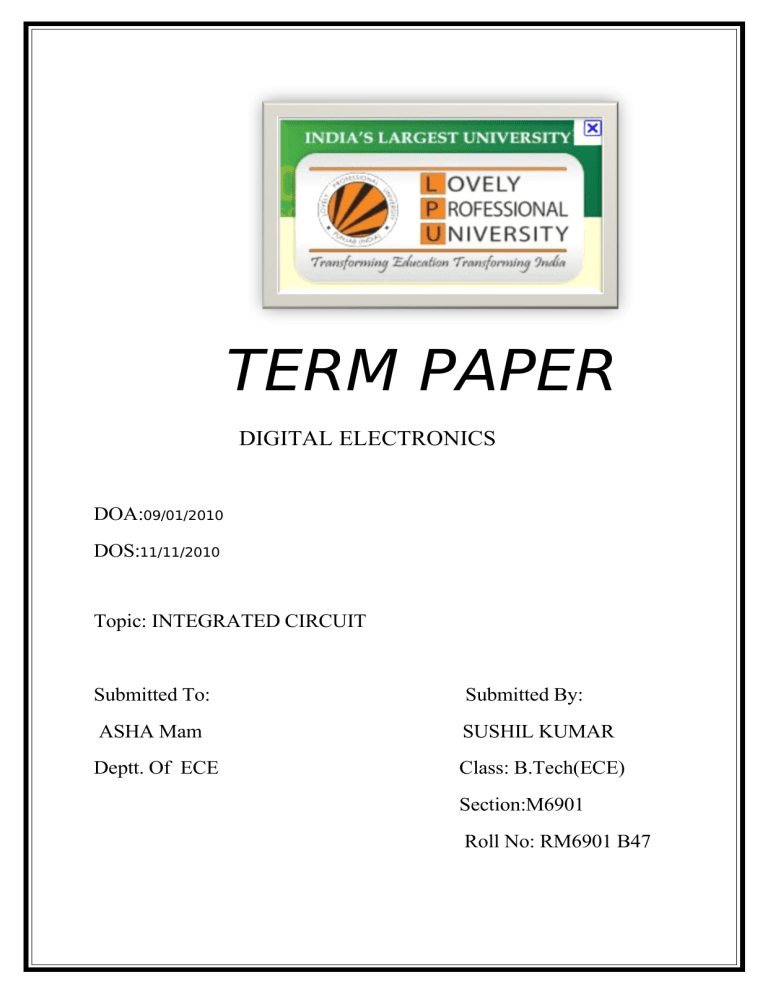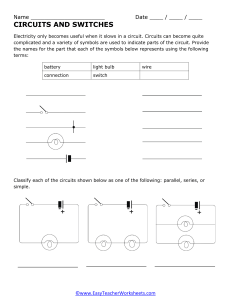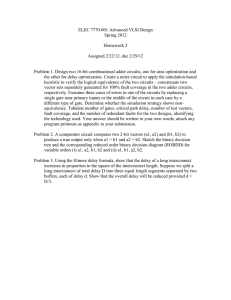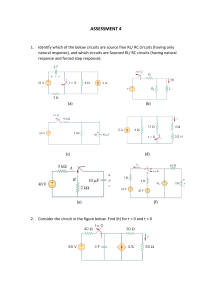
TERM PAPER DIGITAL ELECTRONICS DOA:09/01/2010 DOS:11/11/2010 Topic: INTEGRATED CIRCUIT Submitted To: Submitted By: ASHA Mam SUSHIL KUMAR Deptt. Of ECE Class: B.Tech(ECE) Section:M6901 Roll No: RM6901 B47 ACKNOWLEDGEMENT I would first like to thank my DIGITAL teacher ASHA mam, for her tremendous support and contribution from time to time giving me several information and data related to this term paper . I am also thankful to my friends, who have helped me for making my term paper. Last but not least I would like to thankful to my parents, who has helped me to encourage and giving moral support for making this term paper. SUSHIL KUMAR B. Tech (ECE 3rd Sem.) Table of Contents 1.INTRIDUCTION 2.HISTORY 3.INVENTION 4.ADVANCES N INTEGRATED CIRCUIT 5.MANUFACTURING • FABRICATION • PACKAGING 6.Classification • DIGITAL INTEGRATED CIRCUIT • ANALOG IC • MIXED SIGNAL 7.Logic family • NAND-GATE • NOR-GATE • OR-GATE • EXCLUSIVE-OR-GATE 8.GENERAL CHARACTERISTICS 9.ADVANTAGE 10. APPLICATION OF IC Introduction Integrated circuits were made possible by experimental discoveries which showed that semiconductor devices could perform the functions of vacuum tubes, and by mid-20th-century technology advancements in semiconductor device fabrication. The integration of large numbers of tiny transistors into a small chip was an enormous improvement over the manual assembly of circuits using discrete electronic components. The integrated circuit's mass production capability, reliability, and building-block approach to circuit design ensured the rapid adoption of standardized ICs in place of designs using discrete transistors. The 7400 series of Transistor-transistor logic integrated circuits are historically important as the first widespread family of TTL integrated circuit logic. It was used to build the mini and mainframe computers of the 1960s and 1970s. Several generations of pin-compatible descendants of the original family have since been de-facto standard components. History Although the 7400 series was the first de facto industry standard TTL logic family, secondsourced by several semiconductor companies, there were earlier TTL logic families such as the Sylvania SUHL family, Motorola MC4000 MTTL family (not to be confused with RCA CD4000 CMOS), the National Semiconductor DM8000 family,Fairchild 9300 series, and the Signetics 8200 family. The 5400 and 7400 series were used in many popular minicomputers in the Seventies and early Eighties. The DEC PDP series 'minis' used the 74181 ALU as the main computing element in the CPU. Other examples were the Data General Nova series and Hewlett-Packard 21MX, 1000, and 3000 series. Hobbyists and students equipped with wire wrap tools, a 'breadboard' and a 5-volt power supply could also experiment with digital logic referring to how-to articles in Byte Magazine and Popular Electronics which featured circuit examples in nearly every issue. In the early days of large-scale IC development, a prototype of a new large-scale integrated circuit might have been developed using TTL chips on several circuit boards, before committing to manufacture of the target device in IC form. This allowed simulation of the finished product and testing of the logic before the availability of software simulations of integrated circuits. As of 2007, individual chips can be purchased for approximately 0.25 USD each, depending on the particular chip. Purchased in bulk the price per unit falls to even lower prices per package. INVENTION:Integrated circuits were made possible by experimental discoveries which showed that semiconductor devices could perform the functions of vacuum tubes and by mid-20th-century technology advancements in semiconductor device fabrication. The integration of large numbers of tiny transistors into a small chip was an enormous improvement over the manual assembly of circuits using electronic components. The integrated circuit's mass production capability, reliability, and building-block approach to circuit design ensured the rapid adoption of standardized ICs in place of designs using discrete transistors. There are two main advantages of ICs over discrete circuits: cost and performance. Cost is low because the chips, with all their components, are printed as a unit by photolithography and not constructed as one transistor at a time. Furthermore, much less material is used to construct a circuit as a packaged IC die than as a discrete circuit. Performance is high since the components switch quickly and consume little power (compared to their discrete counterparts) because the components are small and close together. As of 2006, chip areas range from a few square millimeters to around 350 mm2, with up to 1 million transistors per mm2. ADVANCES IN INTEGRATED CIRCUIT Among the most advanced integrated circuits are the microprocessors or "cores", which control everything from computers and cellular phones to digital microwave ovens. Digital memory chips and ASICs are examples of other families of integrated circuits that are important to the modern information society. While the cost of designing and developing a complex integrated circuit is quite high, when spread across typically millions of production units the individual IC cost is minimized. The performance of ICs is high because the small size allows short traces which in turn allows low power logic (such as CMOS) to be used at fast switching speeds. ICs have consistently migrated to smaller feature sizes over the years, allowing more circuitry to be packed on each chip. This increased capacity per unit area can be used to decrease cost and/or increase functionality—see Moore's law which, in its modern interpretation, states that the number of transistors in an integrated circuit doubles every two years. In general, as the feature size shrinks, almost everything improves—the cost per unit and the switching power consumption go down, and the speed goes up. However, ICs with nanometer-scale devices are not without their problems, principal among which is leakage current (see subthreshold leakage for a discussion of this), although these problems are not insurmountable and will likely be solved or at least ameliorated by the introduction of high-k dielectrics. Since these speed and power consumption gains are apparent to the end user, there is fierce competition among the manufacturers to use finer geometries. This process, and the expected progress over the next few years, is well described by the International Technology Roadmap for Semiconductors (ITRS). In current research projects, integrated circuits are also developed for sensoric applications in medical implants or other bioelectronic devices. Particular sealing strategies have to be taken in such biogenic environments to avoid corrosion or biodegradation of the exposed semiconductor materials. As one of the few materials well established in CMOS technology, titanium nitride TiN turned out as exceptionally stable and well suited for electrode applications in medical implants. MANUFACTRURING:(1).FABRICATION:The semiconductors of the periodic table of the chemical elements were identified as the most likely materials for a solid state vacuum tube. Starting with copper oxide, proceeding to germanium, then silicon, the materials were systematically studied in the 1940s and 1950s. Today, silicon monocrystals are the main substrate used for integrated circuits (ICs) although some III-V compounds of the periodic table such as gallium arsenide are used for specialized applications like LEDs, lasers, solar cells and the highest-speed integrated circuits. It took decades to perfect methods of creating crystals without defects in the crystalline structure of the semiconducting material. Semiconductor ICs are fabricated in a layer process which includes these key process steps: Imaging Deposition Etching The main process steps are supplemented by doping and cleaning. Mono-crystal silicon wafers (or for special applications, silicon on sapphire or gallium arsenide wafers) are used as the substrate. Photolithography is used to mark different areas of the substrate to be doped or to have polysilicon, insulators or metal (typically aluminium) tracks deposited on them. Integrated circuits are composed of many overlapping layers, each defined by photolithography, and normally shown in different colors. Some layers mark where various dopants are diffused into the substrate (called diffusion layers), some define where additional ions are implanted (implant layers), some define the conductors (polysilicon or metal layers), and some define the connections between the conducting layers (via or contact layers). All components are constructed from a specific combination of these layers. In a self-aligned CMOS process, a transistor is formed wherever the gate layer (polysilicon or metal) crosses a diffusion layer. Capacitive structures, in form very much like the parallel conducting plates of a traditional electrical capacitor, are formed according to the area of the "plates", with insulating material between the plates. Capacitors of a wide range of sizes are common on ICs. Meandering stripes of varying lengths are sometimes used to form on-chip resistors, though most logic circuits do not need any resistors. The ratio of the length of the resistive structure to its width, combined with its sheet resistivity, determines the resistance. More rarely, inductive structures can be built as tiny on-chip coils, or simulated by gyrators. Since a CMOS device only draws current on the transition between logic states, CMOS devices consume much less current than bipolar devices. A random access memory is the most regular type of integrated circuit; the highest density devices are thus memories; but even a microprocessor will have memory on the chip. (See the regular array structure at the bottom of the first image.) Although the structures are intricate – with widths which have been shrinking for decades – the layers remain much thinner than the device widths. The layers of material are fabricated much like a photographic process, although light waves in the visible spectrum cannot be used to "expose" a layer of material, as they would be too large for the features. Thus photons of higher frequencies (typically ultraviolet) are used to create the patterns for each layer. Because each feature is so small, electron microscopes are essential tools for a process engineer who might be debugging a fabrication process. Each device is tested before packaging using automated test equipment (ATE), in a process known as wafer testing, or wafer probing. The wafer is then cut into rectangular blocks, each of which is called a die. Each good die (plural dice, dies, or die) is then connected into a package using aluminium (or gold) bond wires which are welded and/or Thermosonic Bonded to pads, usually found around the edge of the die. After packaging, the devices go through final testing on the same or similar ATE used during wafer probing. Test cost can account for over 25% of the cost of fabrication on lower cost products, but can be negligible on low yielding, larger, and/or higher cost devices. As of 2005, a fabrication facility (commonly known as a semiconductor lab) costs over $1 billion to construct,[14] because much of the operation is automated. The most advanced processes employ the following techniques: The wafers are up to 300 mm in diameter (wider than a common dinner plate). Use of 65 nanometer or smaller chip manufacturing process. Intel, IBM, NEC, and AMD are using 45 nanometers for their CPU chips. IBM and AMD are in development of a 45 nm process using immersion lithography. Copper interconnects where copper wiring replaces aluminium for interconnects. Low-K dielectric insulators. Silicon on insulator (SOI) Strained silicon in a process used by IBM known as strained silicon directly on insulator (SSDOI). (2).PACKAGING OF IC:The earliest integrated circuits were packaged in ceramic flat packs, which continued to be used by the military for their reliability and small size for many years. Commercial circuit packaging quickly moved to the dual in-line package (DIP), first in ceramic and later in plastic. In the 1980s pin counts of VLSI circuits exceeded the practical limit for DIP packaging, leading to pin grid array (PGA) and leadless chip carrier (LCC) packages. Surface mount packaging appeared in the early 1980s and became popular in the late 1980s, using finer lead pitch with leads formed as either gull-wing or J-lead, as exemplified by small-outline integrated circuit -- a carrier which occupies an area about 30 – 50% less than an equivalent DIP, with a typical thickness that is 70% less. This package has "gull wing" leads protruding from the two long sides and a lead spacing of 0.050 inches. In the late 1990s, PQFP and TSOP packages became the most common for high pin count devices, though PGA packages are still often used for high-end microprocessors. Intel and AMD are currently transitioning from PGA packages on high-end microprocessors to land grid array (LGA) packages. Ball grid array (BGA) packages have existed since the 1970s. Flip-chip Ball Grid Array packages, which allow for much higher pin count than other package types, were developed in the 1990s. In an FCBGA package the die is mounted upside-down (flipped) and connects to the package balls via a package substrate that is similar to a printed-circuit board rather than by wires. FCBGA packages allow an array of input-output signals (called Area-I/O) to be distributed over the entire die rather than being confined to the die periphery. Traces out of the die, through the package, and into the printed circuit board have very different electrical properties, compared to on-chip signals. They require special design techniques and need much more electric power than signals confined to the chip itself. When multiple dies are put in one package, it is called SiP, for System In Package. When multiple dies are combined on a small substrate, often ceramic, it's called an MCM, or MultiChip Module. The boundary between a big MCM and a small printed circuit board is sometimes fuzzy. Classification Integrated circuits can be classified into analog, digital and mixed signal (both analog and digital on the same chip). Digital integrated circuits can contain anything from one to millions of logic gates, flip-flops, multiplexers, and other circuits in a few square millimeters. The small size of these circuits allows high speed, low power dissipation, and reduced manufacturing cost compared with board-level integration. These digital ICs, typically microprocessors, DSPs, and micro controllers work using binary mathematics to process "one" and "zero" signals. Analog ICs, such as sensors, power management circuits, and operational amplifiers, work by processing continuous signals. They perform functions like amplification, active filtering, demodulation, mixing, etc. Analog ICs ease the burden on circuit designers by having expertly designed analog circuits available instead of designing a difficult analog circuit from scratch. ICs can also combine analog and digital circuits on a single chip to create functions such as A/D converters and D/A converters. Such circuits offer smaller size and lower cost, but must carefully account for signal interference. .Logic family In computer engineering, a logic family may refer to one of two related concepts. A logic family of monolithic digital integrated circuit devices is a group of electronic logic gates constructed using one of several different designs, usually with compatible logic levels and power supply characteristics within a family. Many logic families were produced as individual components, each containing one or a few related basic logical functions, which could be used as "building-blocks" to create systems or as so-called "glue" to interconnect more complex integrated circuits. A "logic family" may also refer to a set of techniques used to implement logic within large scale integrated circuits such as a central processor, memory, or other complex function. Some such logic families, such as Complementary Pass-transistor Logic, use static techniques. Other such logic families, such as domino logic, use clocked dynamic techniques to minimize size, power consumption, and delay. Before the widespread use of integrated circuits, various solid-state and vacuum-tube logic systems were used but these were never as standardized and interoperable as the integrated circuit devices. NAND Gate The output is high when either of inputs A or B is high, or if neither is high. In other words, it is normally high, going low only if both A and B are high. The NAND gate and the NOR gate can be said to be universal gates since combinations of them can be used to accomplish any of the basic operations and can thus produce an inverter, an OR gate or an AND gate. The non-inverting gates do not have this versatility since they can't produce an invert. IC 7400 Quad NAND Gate Truth table NAND Gate Operations The NAND gate is called a universal gate because combinations of it can be used to accomplish all the basic functions. Suppose you want a high output when either A or B is high but C is low. The boolean expression and straightforward gate version of this are: But the same task can be accomplished with NAND gates only since NAND's are universal gates. Integrated circuits such as the 7400 make this practical. IC 7402 Quad NOR Gate NOR Gate The output is high only when neither A nor B is high. That is, it is normally high but any kind of non-zero input will take it low. The NOR gate and the NAND gate can be said to be universal gates since combinations of them can be used to accomplish any of the basic operations and can thus produce an inverter, an OR gate or an AND gate. The non-inverting gates do not have this versatility since they can't produce an invert. Truth table IC 7404 Inverting Buffers Buffer Truth table The buffer is a single-input device which has a gain of 1, mirroring the input at the output. It has value for impedance matching and for isolation of the input and output. Inverting Buffer The inverting buffer is a single-input device which produces the state opposite the input. If the input is high, the output is low and vice versa. Truth table This device is commonly referred to as just an inverter. IC 7404 Inverting Buffers The 7404, 74H04, 74S04, 74S04A, 74LS04 share this geometry and function. There are a number of other variations on inverter chips. AND Gate Truth table The output is high only when both inputs A and B are high. IC7408 AND Gates This is an example of convenient packaging of AND gates in integrated circuit form. OR Gate The output is high when either or both of inputs A or B is high. This is logically different from the exclusive OR Truth table IC 7432 OR Gates This is an example of convenient packaging of OR gates in integrated circuit form. Exclusive OR Gate Truth table The output is high when either of inputs A or B is high, but not if both A and B are high. Exclusive OR Gate Logically, the exclusive OR (XOR) operation can be seen as either of the following operations:1. A AND NOT B OR B AND NOT A 2. A OR B AND NOT A AND B which can be implemented by the gate arrangements shown. They can also be implemented using NAND gates only. IC 7486 Exclusive-OR This is an example of convenient packaging of XOR gates in integrated circuit form. General characteristics There are several families of logic ICs numbered from 74xx00 onwards with letters (xx) in the middle of the number to indicate the type of circuitry, eg 74LS00 and 74HC00. The original family (now obsolete) had no letters, eg 7400. The 74LS (Low-power Schottky) family (like the original) uses TTL (Transistor-Transistor Logic) circuitry which is fast but requires more power than later families. The 74 series is often still called the 'TTL series' even though the latest ICs do not use TTL! The 74HC family has High-speed CMOS circuitry, combining the speed of TTL with the very low power consumption of the 4000 series. They are CMOS ICs with the same pin arrangements as the older 74LS family. Note that 74HC inputs cannot be reliably driven by 74LS outputs because the voltage ranges used for logic 0 are not quite compatible, use 74HCT instead. The 74HCT family is a special version of 74HC with 74LS TTL-compatible inputs so 74HCT can be safely mixed with 74LS in the same system. In fact 74HCT can be used as low-power direct replacements for the older 74LS ICs in most circuits. The minor disadvantage of 74HCT is a lower immunity to noise, but this is unlikely to be a problem in most situations. The CMOS circuitry used in the 74HC and 74HCT series ICs means that they are static sensitive. Touching a pin while charged with static electricity (from your clothes for example) may damage the IC. In fact most ICs in regular use are quite tolerant and earthing your hands by touching a metal water pipe or window frame before handling them will be adequate. ICs should be left in their protective packaging until you are ready to use them. 74LS family TTL characteristics: Supply: 5V ±0.25V, it must be very smooth, a regulated supply is best. In addition to the normal supply smoothing, a 0.1µF capacitor should be connected across the supply near the IC to remove the 'spikes' generated as it switches state, one capacitor is needed for every 4 ICs. Inputs 'float' high to logic 1 if unconnected, but do not rely on this in a permanent (soldered) circuit because the inputs may pick up electrical noise. 1mA must be drawn out to hold inputs at logic 0. In a permanent circuit it is wise to connect any unused inputs to +Vs to ensure good immunity to noise. Outputs can sink up to 16mA (enough to light an LED), but they can source only about 2mA. To switch larger currents you can connect a transistor. Fan-out: one output can drive up to 10 74LS inputs, but many more 74HCT inputs. Gate propagation time: about 10ns for a signal to travel through a gate. Frequency: up to about 35MHz (under the right conditions). Power consumption (of the IC itself) is a few mW. Advantages There are two main advantages of ICs over discrete circuits: cost and performance. Cost is low because the chips, with all their components, are printed as a unit by photolithography and not constructed one transistor at a time. Furthermore, much less material is used to construct a circuit as a packaged IC die than as a discrete circuit. Performance is high since the components switch quickly and consume little power (compared to their discrete counterparts), because the components are small and close together. As of 2006, chip areas range from a few square mm to around 350 mm², with up to 1 million transistors per mm². APPLICATION OF IC:An application-specific integrated circuit (ASIC) (pronounced /ˈeɪsɪk/) is an integrated circuit (IC) customized for a particular use, rather than intended for general-purpose use. For example, a chip designed solely to run a cell phone is an ASIC. Application specific standard products (ASSPs) are intermediate between ASICs and industry standard integrated circuits like the 7400 or the 4000 series. As feature sizes have shrunk and design tools improved over the years, the maximum complexity (and hence functionality) possible in an ASIC has grown from 5,000 gates to over 100 million. Modern ASICs often include entire 32-bit processors, memory blocks including ROM, RAM, EEPROM, Flash and other large building blocks. Such an ASIC is often termed a SoC (system-on-a-chip). Designers of digital ASICs use a hardware description language (HDL), such as Verilog or VHDL, to describe the functionality of ASICs. Field-programmable gate arrays (FPGA) are the modern-day technology for building a breadboard or prototype from standard parts; programmable logic blocks and programmable interconnects allow the same FPGA to be used in many different applications. Conclusion The 7400 series of TTL integrated circuits are historically important as the first widespread family of IC logic. It was used to build the mini and mainframe computers of the sixties and seventies. Several generations of pin-compatible descendants of the original family has since been de-facto standard-components for more than 40 years, and seen use in many types of products and equipment besides computers.At the moment the most common logic families still are the LS-TTL and the HC and HCT families, although BCT logic also is starting to become popular. Low voltage logic families are becoming more important, with AHC logic gaining popularity. Because not every manufacturer supports every logic family, several families of logic circuits will continue to be used. References 1. hyperphysics.phy-astr.gsu.edu/Hbase/Electronic/nand.html - 8k 2. John Hewes 2008, The Electronics Club, www.kpsec.freeuk.com 3. Wikipedia, the free encyclopedia 4. Mead, C. and Conway, L. (1980). Introduction to VLSI Systems. Addison-Wesley. thanks
![sheet 3 electric circuits[2]](http://s2.studylib.net/store/data/026183691_1-6b03f70d4f07d30f02a70c2aa3ef4720-300x300.png)




